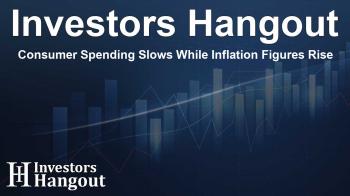Consumer Spending Slows While Inflation Figures Rise

Understanding Recent Inflation Trends
Recent data indicates an end to the three consecutive months of declines in the PCE inflation rate. The U.S. Bureau of Economic Analysis reported that Personal Consumption Expenditures (PCE) inflation rose to 2.3% in the latest month, which is an increase from 2.1% in the previous month. This new rate aligns perfectly with economists’ forecasts, showcasing a month-to-month rise of 0.1%. The upward movement in PCE is noteworthy as it coincided with the implementation of new tariffs, marking May as a significant month in this context.
Core PCE, a measure that excludes volatile food and energy prices, also saw a notable rise, jumping to 2.7%, surpassing economists' expectations of 2.6%. This increase in core PCE, which rose by 0.2% in the month, reflects ongoing inflationary pressures that may impact consumer behavior and the economy's overall health.
Consumer Spending Trends Unfold
Despite the inflation uptick, consumer spending has taken a downturn. The PCE figures revealed a decrease of $29.3 billion, translating to a 0.1% decline in consumer spending. This figure was less than the slightly more optimistic forecast of a 0.2% rise from economists for May. There was a significant drop in spending on goods, particularly in the automotive sector, which saw a reduction of $49.2 billion. While some categories like nondurable goods and apparel reported slight increases, overall spending habits appear to be tightening.
Interestingly, services spending did see an increase of $19.9 billion, offering a buffering effect against the drop in goods spending. However, it is noteworthy that sectors faced mixed outcomes. For instance, while housing and utilities saw spending rise by $13.7 billion, food services registered a drop of $10.6 billion alongside a $5.7 billion decrease in financial service spending.
Trends in Personal Income
The data paints a concerning picture regarding personal income as it fell by $109.6 billion, or 0.4%, below the expected figures by economists who had predicted a 0.3% rise. Disposable personal income, after accounting for current taxes, also saw a slump, decreasing by $125 billion, or 0.6%. This notable decline potentially exacerbates the issue of consumer spending as households may have less to spend due to falling incomes.
Experts in economic analysis suggest that the Fed's preferred measures indicate an average projection of 3.1% for inflation by 2025, which significantly exceeds the 2% target. The rising inflation is casting a shadow over consumer confidence, as indicated by decreased spending and retail sales, which dropped by 0.9% in May. This decline is notably sharper than anticipated, particularly affecting larger purchases such as cars. The economic outlook suggests a challenging landscape where slow growth, high inflation, and increasing unemployment may converge, resembling stagflation—a concern many economists are monitoring.
Market reactions to these findings were somewhat optimistic, as major indexes, including the Dow Jones, showed positive trends, climbing by approximately 275 points in early trading sessions. The S&P 500 and Nasdaq also experienced gains of about 30 and 75 points, respectively. However, the implications of this economic data are profound as it adjusts outlooks on the Federal Reserve’s potential interest rate decisions. According to the CME FedWatch poll, there’s now an increased sentiment (81%) among traders anticipating that the Fed may hold current rates steady in their July meeting, a slight uptick from the previous day’s 79% prediction.
Frequently Asked Questions
What does PCE inflation measure?
PCE inflation measures the average change over time in the prices paid by consumers for goods and services, reflecting consumer behavior and economic conditions.
Why is Core PCE important?
Core PCE excludes food and energy prices to provide a clearer picture of underlying inflation trends without the volatility these commodities can introduce.
How does consumer spending affect the economy?
Consumer spending accounts for a significant portion of economic activity; when it decreases, it can slow down economic growth and negatively impact companies and employment rates.
What might the Fed do in response to inflation data?
The Federal Reserve may choose to adjust interest rates to control inflation and stabilize the economy, primarily by influencing borrowing costs for consumers and businesses.
What are the potential economic impacts of rising inflation?
Rising inflation can lead to decreased purchasing power for consumers, changes in monetary policy, and potential economic slowdowns if growth does not keep pace with rising prices.
About The Author
Contact Addison Perry privately here. Or send an email with ATTN: Addison Perry as the subject to contact@investorshangout.com.
About Investors Hangout
Investors Hangout is a leading online stock forum for financial discussion and learning, offering a wide range of free tools and resources. It draws in traders of all levels, who exchange market knowledge, investigate trading tactics, and keep an eye on industry developments in real time. Featuring financial articles, stock message boards, quotes, charts, company profiles, and live news updates. Through cooperative learning and a wealth of informational resources, it helps users from novices creating their first portfolios to experts honing their techniques. Join Investors Hangout today: https://investorshangout.com/
The content of this article is based on factual, publicly available information and does not represent legal, financial, or investment advice. Investors Hangout does not offer financial advice, and the author is not a licensed financial advisor. Consult a qualified advisor before making any financial or investment decisions based on this article. This article should not be considered advice to purchase, sell, or hold any securities or other investments. If any of the material provided here is inaccurate, please contact us for corrections.

